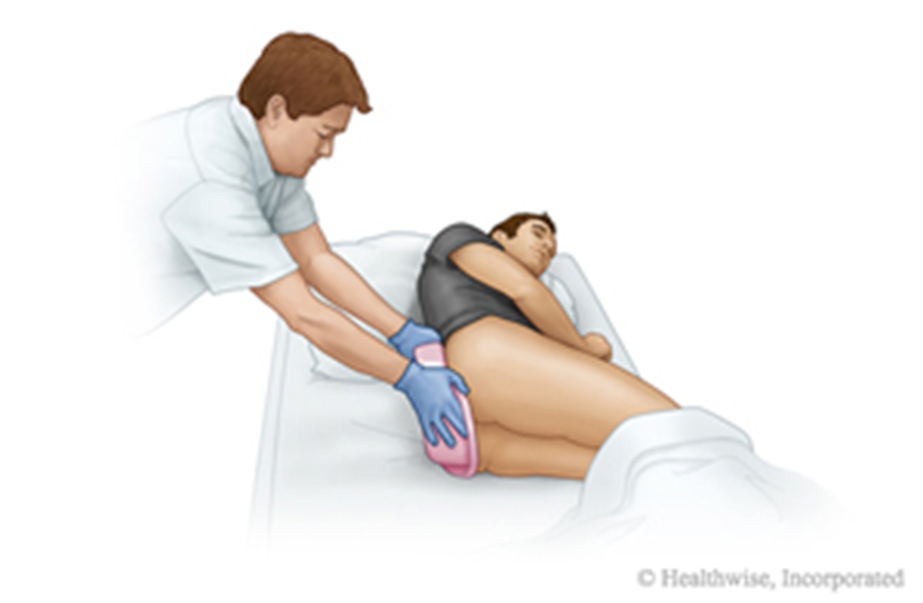A nurse observes a practical nurse (PN) pouring warm water over the perineal area of a female client who has frequent urinary incontinence while the client is positioned on a bedpan. Which action should the nurse take?
Evaluate the effectiveness of this measure to stimulate client voiding.
Recommend a complete bath to cleanse the perineal area more fully.
Suggest contacting the healthcare provider for a prescription for catheter insertion.
Instruct the PN that this technique promotes infection in elderly females.
The Correct Answer is A
Choice A reason: Pouring warm water over the perineal area can stimulate the micturition reflex, which may help the client void. It is a non-invasive, first-line intervention to promote natural voiding in clients with urinary incontinence. The nurse should evaluate its effectiveness as it can be a simple yet effective method to assist the client.
Choice B reason: While recommending a complete bath may help maintain hygiene, it does not directly address the immediate need to stimulate voiding. The nurse's priority is to manage the incontinence issue effectively and a bath can be considered after addressing the client's immediate needs.
Choice C reason: Suggesting catheter insertion may be premature without first attempting less invasive measures. Catheterization carries risks such as infection and should be considered only when other interventions are ineffective or not feasible.
Choice D reason: There is no evidence to suggest that pouring warm water over the perineal area promotes infection in elderly females. In fact, proper perineal care is essential in preventing infections, especially in clients with incontinence.

Nursing Test Bank
Naxlex Comprehensive Predictor Exams
Related Questions
Correct Answer is ["A","B","D","F"]
Explanation
Choice A Reason: Weight reduction treatment is a modifiable risk factor for prediabetes. Losing a small amount of weight, around 5% to 7% of body weight, can significantly lower the risk of developing type 2 diabetes. For a 200-pound person, this means losing about 10 to 14 pounds.
Choice B Reason: Exercise planning is crucial as it helps improve insulin sensitivity and glucose metabolism. The recommendation is at least 150 minutes per week of moderate-intensity physical activity, such as brisk walking or light cycling.
Choice C Reason: Long-acting insulin is not typically used in the management of prediabetes. Insulin therapy is more commonly a part of the treatment regimen for individuals with type 1 diabetes or those with type 2 diabetes who cannot control their blood glucose levels with oral medications.
Choice D Reason: Nutrition education is essential for managing prediabetes. A diet rich in fiber, whole grains, and non-starchy vegetables, and low in added sugars and saturated fats, can help manage blood glucose levels3.
Choice E Reason: Extra carbohydrates are not recommended for prediabetes management as they can lead to increased blood glucose levels. Instead, a balanced diet with controlled carbohydrate intake is advised.
Choice F Reason: Oral antidiabetic medications, such as metformin, may be prescribed to help lower blood glucose levels and improve insulin sensitivity in individuals with prediabetes.
Choice G Reason: Short-acting insulin is not indicated for prediabetes management for the same reasons as long-acting insulin; it is not typically part of the treatment regimen unless the individual has progressed to type 2 diabetes and requires insulin therapy.
Correct Answer is A
Explanation
Choice A reason: Before administering IV fluids containing potassium chloride, it is crucial to ensure that the client has adequate urinary output, typically between 30 to 60 mL/hr. This indicates good kidney function, which is necessary for the excretion of potassium to prevent hyperkalemia, a potentially life-threatening condition.
Choice B reason: While magnesium levels can affect potassium levels, they are not the most critical assessment before potassium infusion. However, it is important to monitor magnesium levels as part of the overall electrolyte balance, especially in diabetic ketoacidosis.
Choice C reason: The size of the IV catheter is important for administration purposes, but it is not the most critical assessment data before starting potassium infusion. The catheter size affects the flow rate and comfort during infusion but does not impact the decision to start the infusion.
Choice D reason: Serum glucose level is a vital parameter to monitor in diabetic ketoacidosis, but it is not the most critical assessment before starting potassium infusion. The primary concern with potassium infusion is kidney function, as assessed by urinary output.
Whether you are a student looking to ace your exams or a practicing nurse seeking to enhance your expertise , our nursing education contents will empower you with the confidence and competence to make a difference in the lives of patients and become a respected leader in the healthcare field.
Visit Naxlex, invest in your future and unlock endless possibilities with our unparalleled nursing education contents today
Report Wrong Answer on the Current Question
Do you disagree with the answer? If yes, what is your expected answer? Explain.
Kindly be descriptive with the issue you are facing.
